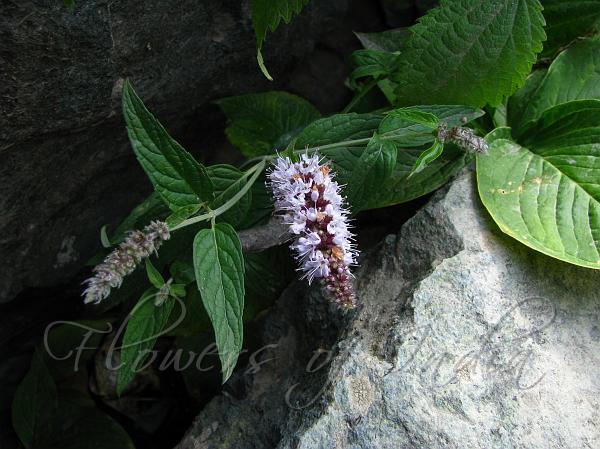|
| Himalayan Horsemint |
|

|

| File size | 583683 |
| Original date | 8/11/13 9:26 AM |
| Resolution | 2048 x 1536 |
| Flash | Flash did not fire, auto |
| Focal length | 6.0mm |
| Exposure time | 1/80s |
| Aperture | 4.5 |
| Focus Distance | |
| Metering Mode | Multi-segment |
| Camera make | Canon |
| Camera model | Canon PowerShot S5 IS |
| Sensor type | OneChipColorArea |
|
|
|
|
Photo: |
Botanical name: Mentha longifolia subsp. hymalaiensis Family: Lamiaceae (Mint family)
Synonyms: Mentha royleana Benth. subsp. hymalaı̈ensis Briq.
Synonyms: Mentha royleana Benth. subsp. hymalaı̈ensis Briq.
Himalayan Horsemint is a very aromatic perennial
herb, with tiny lilac flowers borne in slender spikes which may be
interrupted below. Spikes are borne at branch ends and form a lax
densely hairy inflorescence. Flowering spikes are 2.5-8 cm long, 8-12
mm broad. Flowers are about 3 mm across, hairy outside, stamens
protruding, with 5 triangular sepals, and lanceshaped bracts. Leaves
are oblong to obovate to lanceshaped, 2.5-8 cm long, saw-toothed on the
margins, with rounded base. Leaves are densely hairy, paler on the
underside. Himalayan Horsemint is found in the Himalayas, from
Afghanistan to C Nepal, at altitudes of 1500-3800 m. Flowering:
July-August.
Medicinal uses: In Jammu and Kashmir, India,
the essential oil is used for flavoring confectionery. A tea from the
leaves is taken as a cooling medicine. In Uttarakhand, the herb is used
for gastrointestinal disorders, cough, colds, and chronic fever. In
Nepal, the leaf juice is applied to cuts and wounds as an antiseptic; a
leaf decoction is taken to relieve sore throat.
In Jammu and Kashmir, India,
the essential oil is used for flavoring confectionery. A tea from the
leaves is taken as a cooling medicine. In Uttarakhand, the herb is used
for gastrointestinal disorders, cough, colds, and chronic fever. In
Nepal, the leaf juice is applied to cuts and wounds as an antiseptic; a
leaf decoction is taken to relieve sore throat.
Medicinal uses:
 In Jammu and Kashmir, India,
the essential oil is used for flavoring confectionery. A tea from the
leaves is taken as a cooling medicine. In Uttarakhand, the herb is used
for gastrointestinal disorders, cough, colds, and chronic fever. In
Nepal, the leaf juice is applied to cuts and wounds as an antiseptic; a
leaf decoction is taken to relieve sore throat.
In Jammu and Kashmir, India,
the essential oil is used for flavoring confectionery. A tea from the
leaves is taken as a cooling medicine. In Uttarakhand, the herb is used
for gastrointestinal disorders, cough, colds, and chronic fever. In
Nepal, the leaf juice is applied to cuts and wounds as an antiseptic; a
leaf decoction is taken to relieve sore throat. | Identification credit: Amit Chauhan, Anzar Khuroo, Gurcharan Singh | Photographed on Amarnath Yatra route & in Nubra Valley, Ladakh. |
• Is this flower misidentified? If yes,